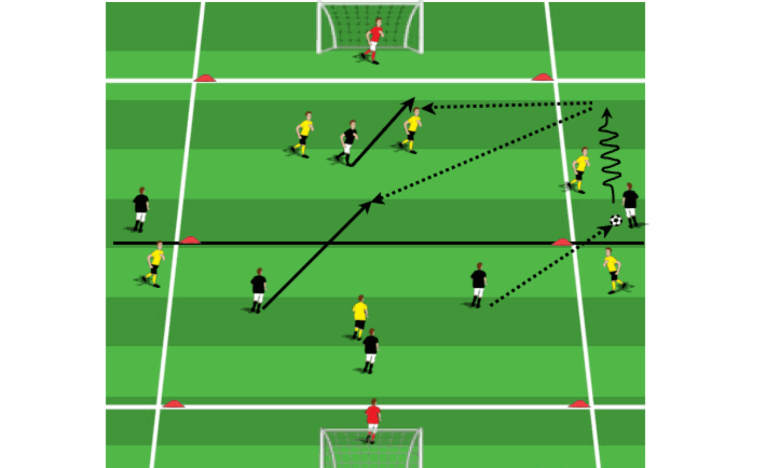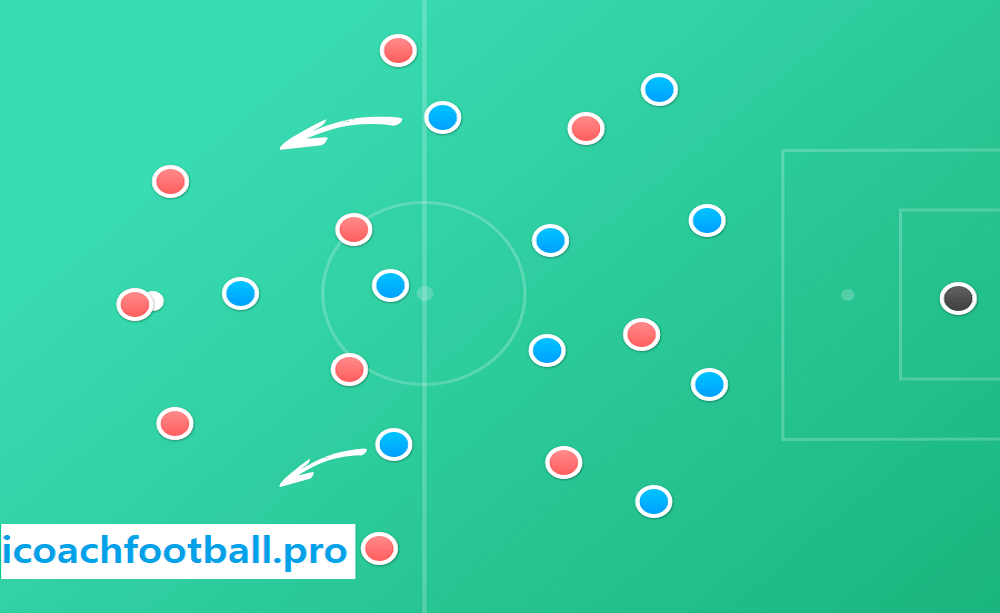Table of Contents
Introduction – Small-sided games to train the 4-2-3-1 PDF
Coaching the 4-2-3-1 is not just a formation or system of play. It can also be described as a philosophy on
how the game is played. This philosophy is based around flexibility. One of the strengths of the 4-2-3-1 is
the flexibility it provides with the interchanging of positions of the midfielders and forwards. This is one of
the reasons opponents find it really hard to play against.
This philosophy can and should be adapted at a younger age too. So for those age groups that don’t play
11v11, this free eBook shows you how to adapt the 4-2-3-1 to the small-sided soccer that younger teams
play. Not only that, if you have a team that is just a year or two away from moving to 11v11, this eBook is
perfect for helping them make the transition from the smaller numbers they are playing to the full blown
version of the 11v11 4-2-3-1.
GREAT FOR TRAINING SESSIONS – The material in, ‘Small-Sided Games to Train the 4-2-3-1’ is also
perfect for using the smaller numbers to create your own 4-2-3-1 training sessions. If you have 18 players or
less on your team, you can use the ideas in this eBook to set up small-sided games specifically designed to
teach the 4-2-3-1.
Making the transition from small-sided football to 11-a-side football
In youth football, most players and coaches have a problem with moving to what is a more complex game;
there is more space on a field that is much longer to reach the opposition goal than what the players
moving from 7 or 8-a-side football, meaning passing and running distances should be much longer, but also
with more players, positioning, problem solving and decision making are much more difficult.
In many countries to help building from the back, some non-competitive youth football is played with a
‘retreating line’ meaning that the GK can roll the ball out to a defender who can take a touch before any
opposition player can move ahead of the retreating line and press the ball. In small-sided football, this gives
players time to receive and analyse the options they have – passing options or to dribble out of the 1st zone
of play.
As the move to 11-a-side football is made, the retreating line is taken away, giving the GK the dilemma to
pass out to a defender who will likely be pressed, and if he loses the ball, the move to 11-a-side also has a
problem for GK’s – large goals which are often far too large for young GK’s to be able to save any shots that
are near the crossbar. Most strikers will try to shoot high so that the small GK cannot make a save in the
overly large goals.

Main changes for players and coaches moving to 11-a-side
More players – more complex game
More spaces – a more athletic game than SSG’s
Larger goals – easier to score for players who can kick the ball high over long distances
Wider field – attacking angles have changed and set pieces are more difficult to use
Planning ahead for 11-a-side

When planning ahead for 11-a-side, the coach should not lose focus of what the coach’s role is – to develop
children to be good people socially, good footballers and to have a sense of morality when playing the
game. Some coaches are ‘Win at all costs’ coaches and will ignore the development of players to replace
them with bigger and stronger, more effective players for short term gain.
This should be avoided – stick with the players you have and educate them to play the game better; winning is NOT important, it is a by- product of producing the best players in the correct learning environment. By producing technical and tactical footballers, players will learn how to use their skills in the correct areas for maximum efficiency, which in turn leads to dominating possession and from this, making more scoring chances, winning matches and success should be gained in this way.
The main things the coach should look to retain are;
the teams current playing style, maintain technique, speed and tactical awareness over strength. Don’t recruit bigger kids for short term gain. When planning ahead of the 11-a-side season, using SSG’s are vitally important. Players still need to have touches on the ball and play in tight spaces – playing 11-a-side matches in training sessions just to give players a feel for the size of the field may help but how many touches on the ball will they have?
I used a lot of shadow play with 11 players on a daniel.sundstrom@ymail.com field to give players and idea
of how we would play in 11-a-side friendlies leading up to the new 11-a-side season. In this, I places players
in the positions I thought they would play within the formation I expected to play and placed defenders into
the play to ask them to press the ball, meaning the 11 players would need to move the ball away from
pressure and ask players not directly or indirectly involved in play to maintain a shape to retain possession
when attacking.
Creating a training programmed to be ready for the 11-a-side season when it arrives
To plan ahead for the 11-a-side season which in most countries brings 1st time competitive league based
play for points, coaches should begin a slow building process around 6 months before the start of the
season, using simple ideas in conditioned games such as a longer, narrow field, and increase the number of
players in shadow play for both attack and defence gradually.
Coaches must still develop the players for the long-term goal of becoming a good footballer, but as players
like to win and test themselves against other players, preparing them properly can help them achieve this in
the correct manner – some coaches will bring in lots of new players and tell the players that if they don’t
play well, they don’t get on for very long, if at all; as I have seen many times – this should be avoided, and
coaches like this should re-evaluate what is important to kids football.
The correct manner is to properly prepare them for the step over to the larger field and ultimately more
complex game. This should be done so that players can still play the usual small-sided games but for the
players to know that what they do in the small-sided game is very important for the success of the 11-a-side
game. Some players will completely change the way they play from SSG’s when moving to 11-a-side, and
we don’t want this to happen, especially to thoughtful, intelligent players.
